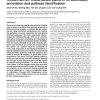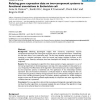153 search results - page 14 / 31 » Clustering the annotation space of proteins |
BMCBI
2007
13 years 9 months ago
2007
Background: Identification of protein interacting sites is an important task in computational molecular biology. As more and more protein sequences are deposited without available...
CVPR
2010
IEEE
14 years 5 months ago
2010
IEEE
The dynamic texture (DT) is a probabilistic generative model, defined over space and time, that represents a video as the output of a linear dynamical system (LDS). The DT model ...
BMCBI
2005
13 years 9 months ago
2005
Background: Several problems exist with current methods used to align DNA sequences for comparative sequence analysis. Most dynamic programming algorithms assume that conserved se...
NAR
2006
13 years 9 months ago
2006
There is an increasing need to automatically annotate a set of genes or proteins (from genome sequencing, DNA microarray analysis or protein 2D gel experiments) using controlled v...
BMCBI
2008
2008
Relating gene expression data on two-component systems to functional annotations in Escherichia coli
13 years 9 months ago
Background: Obtaining physiological insights from microarray experiments requires computational techniques that relate gene expression data to functional information. Traditionall...


